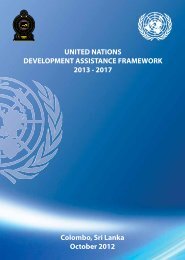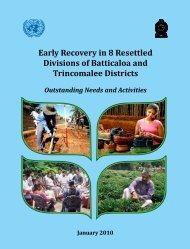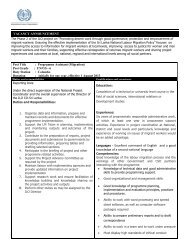Sri Lanka Human Development Report 2012.pdf
Sri Lanka Human Development Report 2012.pdf
Sri Lanka Human Development Report 2012.pdf
You also want an ePaper? Increase the reach of your titles
YUMPU automatically turns print PDFs into web optimized ePapers that Google loves.
ural enterprises. Cash in hand and borrowing from family<br />
and friends provide the biggest share of funds for them. 260<br />
Since financial institutions are extremely risk-averse, they<br />
can be reluctant to finance agricultural investments, which<br />
is one barrier to improving output. Credits for crops other<br />
than tea, rubber and paddy are negligible (Figure 5.8). This<br />
hinders innovation, diversification into high-value crops<br />
and adaptation of technologies to boost productivity.<br />
For small businesses, access to finance can be constrained<br />
by low financial literacy, including the lack of skills in<br />
developing feasible business plans and adhering to loan<br />
application procedures. There is a need to both build<br />
awareness, and simplify procedures and rules. 261<br />
To tackle some of these problems, the Central Bank<br />
of <strong>Sri</strong> <strong>Lanka</strong>, after consultation with a cross-section of<br />
stakeholders, drafted the Microfinance Institution Act,<br />
with a series of amendments now under review. The<br />
government has provided funding for microfinance<br />
through government institutions such as the National<br />
<strong>Development</strong> Trust Fund and the state banks.<br />
Access to information and communication<br />
Information and communications technology<br />
infrastructure provides access to technology, knowledge<br />
and innovation; facilitates new management and<br />
Figure 5.8: Commercial Banks: Sectoral Distribution of Loans and Advances Granted to<br />
agriculture and Fishing, 2010<br />
Source: Central Bank of <strong>Sri</strong> <strong>Lanka</strong> 2010<br />
The supply of non-financial services, such as technical<br />
advice, through microfinance institutions is low. Where<br />
these services are provided, they are typically limited in<br />
range and quality. 262 Several ministries, departments and<br />
government acts control the operations of microfinance<br />
organizations, making the regulatory framework<br />
fragmented and confusing. This discourages investment<br />
in microfinance, as do restrictions on the mobilization of<br />
savings.<br />
organizational systems; and opens doors to markets and<br />
global value chains. 263 Although telecommunication<br />
services have improved over the years, they are not<br />
yet adequate to support sustained, robust enterprise<br />
development.<br />
Mobile and wireless services have rapidly increased, to the<br />
point where the entire country is connected. <strong>Sri</strong> <strong>Lanka</strong><br />
Chapter 5 Bridging <strong>Human</strong> <strong>Development</strong> Gaps: Employment and Livelihoods 93






